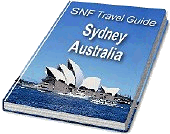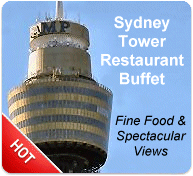Queen Victoria Building
Posted on March 8, 2008 - Filed Under Historic Sites, Sydney Shopping
Tags: Queen Victoria Building, QVB, Sydney Historic Sites, Sydney Shopping, things to do in Sydney
The Queen Victoria Building is both a magnificent historical landmark and a shopping paradise. Affectionately referred to as the QVB, it has been described as the “most beautiful shopping centre in the world” by Pierre Cardin. It is a hub of activity and attracts hundreds of locals and tourists every day.
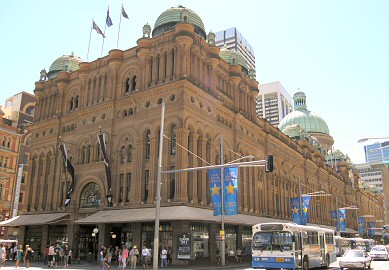
The Queen Victoria Building was built on the site of the George Street Markets, Sydney’s produce markets in the 1800s. Architect George McRae submitted four separate designs for the building to the Sydney City Council, each with their own style. The styles were Renaissance, Gothic, Romanesque Revival and Queen Anne. Ultimately, the Romanesque Revival style was chosen. Construction began in 1893.
Sydney was in the midst of a recession in 1893 and many people were out of work. The building project provided many job opportunities, especially for construction workers and artists and gave some much needed relief for many families.
Construction was completed in 1898 and the building was named after Queen Victoria, the reigning monarch at the time. It originally featured coffee shops, showrooms, a business environment for various tradesmen and a concert hall. The concert hall has since become a library.
Several alterations were made over the following years. For example, the original concept of a glass-roofed shopping street was lost when much of the building was converted into office space. Sadly, as time went on the building slowly deteriorated and in 1959, it was threatened with demolition.
Thankfully, the building was rescued and underwent extensive restorations and refurbishment. It was reopened in 1984 and although it is now home to over 200 modern shops, it still retains its turn-the-century charm.
The Architecture:
The architecture of the Queen Victoria Building is stunning both inside and out and offers a unique contrast to the surrounding modern structures. Even if you do not wish to shop, it is worth the time to have a look around.
From the outside you will notice the large central dome. It is 20 metres in diameter and is made up of an inner glass dome and an exterior copper-sheathed dome, topped by a domed cupola. Other smaller domes also feature prominently along the roof.
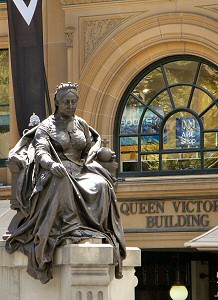
At the main entrance is a statue of Queen Victoria by Irish sculptor, John Hughes. The statue once stood outside the Irish Houses of Parliament in Leinster House, Dublin but in 1947 it was given to the people of Sydney by the Government of the Republic of Ireland. It was placed here in 1987.
The Royal Wishing Well stands nearby. It features a bronze sculpture of Islay, Queen Victoria’s favourite dog. A recorded message by radio personality, John Laws encourages passers-by to make a donation in the well, with all proceeds going to deaf and blind children.
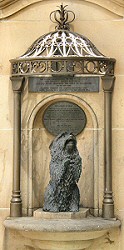
Inside the Queen Victoria Building you will find beautiful wood panelling, sweeping staircases and stunning stained-glass windows, including a window featuring the original crest of arms of the city of Sydney. While you are there, make sure you look down at the tiles on the mosaic floor. Many are the originals.
The upper levels of the building overlook the ground floor, creating a beautiful open space full of charming shops and cafes. If you have time, try one of the cafes on the upper levels and relax as you people-watch in exquisite surroundings.
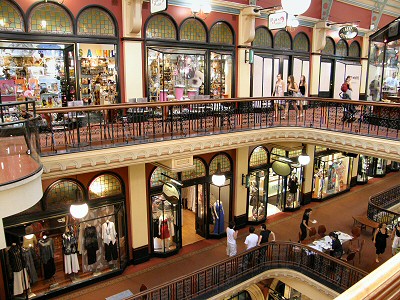
Exhibits and Attractions:
The upper floors feature a number of exhibits and attractions that are well worth a look.
The main attraction is the Royal Clock – This spectacular mechanical clock was made by the Queen’s clockmaker and resembles Balmoral Castle. It is suspended from the ceiling and is the world’s largest hanging animated turret clock. Every hour, on the hour between 9am and 9pm, it’s mechanical action figures sound the trumpets and act out a Royal Pageant. It features six scenes from England’s history including King John signing the Magna Carta in 1215, Queen Elizabeth I knighting Sir Frances Drake in 1588 and the beheading of Charles I in 1649.
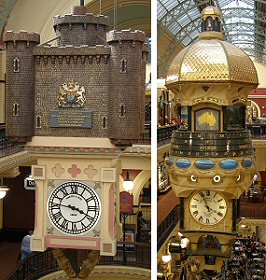
Others attractions include:
· The Great Australia Clock – This clock stands 10 metres tall and depicts 33 scenes from Australia’s history from both Aboriginal and European perspectives. An Aboriginal hunter continuously circles the exterior of the clock to represent the never-ending passage of time.
· Replicas of the Crown Jewels – These were made by the crown jeweller’s craftsmen and are on display in the top gallery
· A Wax Model of Queen Victoria – She is dressed in full coronation regalia and is seated on an ornate chair
· A Letter from Queen Elizabeth II – Written in 1986, it is to be opened by the Lord Mayor of Sydney in 2085
· A tribute to recipients of the Victoria Cross
· Replicas of Royal paintings
The upper floors are usually fairly quiet and provide a nice escape from the bustle of the ground floors.
The Shops:
Over 200 stores call the QVB home. The ground floors feature well-known fashion brands like Esprit, Ralph Lauren, Country Road, Oroton and Guess. The upper floors focus more on boutique shopping, jewellery, international and Australian art, antiques, Australian craft and quality Australian souvenirs.
You can buy almost anything at the Queen Victoria Building, but be aware that most (not all) stores are fairly upmarket and have the prices to match. Generally, the higher the level, the more expensive the prices are likely to be.
Important Information:
Guided Tours:
Guided tours take place twice daily. They run at 11:30am and 2:30pm Monday to Saturday and 12:00pm and 2:30pm on Sundays. Tours cost $10 Au each (free with a See Sydney Card) and run for one hour.
Tours cover a wide range of interesting facts and give a good overview of the history of this remarkable building. Stories will cover everything from the original concept to trading difficulties during World War II.
Night Tours are also available for $25 Au each. Night tours include the regular tour with the added bonus of giving you the opportunity to visit inner and outer domes via spiral staircases. Champagne and savouries are also served under the grand dome as you listen to a piano and violin duet.
Tours can be booked by contacting the Concierge Desk on (02) 9264 9209.
Location:
The Queen Victoria Building is located in the centre of the city, adjacent to Town Hall. It occupies an entire city block bounded by George, Market, York and Druitt Streets.
The Queen Victoria Building can be easily reached by train or by bus. Both Town Hall Station and Pitt Street Mall are directly connected with the lower levels of the building by underground passageways.
Paid parking is available on site and can be accessed via York Street.
Nearby Attractions:
Nearby attractions include Town Hall, Pitt Street Mall, Hyde Park and Darling Harbour.
Opening Hours:
The Queen Victoria Building remains open 24 hours a day. However store hours are:
Monday: 9:00am-6:00pm
Tuesday: 9:00am-6:00pm
Wednesday: 9:00am-6:00pm
Thursday: 9:00am-9:00pm
Friday: 9:00am-6:00pm
Saturday: 9:00am-6:00pm
Sunday and public holidays: 11:00am-5:00pm
Stores located on the upper levels open at 10:00am. Some stores and cafes may remain open for longer hours.
Admission:
There are no admission fees for the Queen Victoria Building.
Food Services:
The QVB caters to all tastes when it comes to food. The lower levels feature several options including a bakery and an inexpensive food court. Cafes and restaurants can also be found on the upper levels.
Access:
The Queen Victoria Building is wheelchair accessible. Lifts are located at both ends of the building to provide access to the upper floors.
Contact Details:
You can contact the Queen Victoria Building directly on (02) 9264 9209.
Have You Visited The Queen Victoria Building?
Please share your experiences of or questions about the Queen Victoria Building in the comments box below.
Telstra Stadium Tours
Posted on January 13, 2008 - Filed Under Homebush, Sydney Sport Venues
Tags: Homebush, Sydney Olympic Stadium, Telstra Stadium, Telstra Stadium Tours, things to do in Sydney
Telstra Stadium was built as the main stadium for the Sydney 2000 Olympic Games. At the time, it was the largest Olympic Stadium ever built and the largest stadium in Australia. It is most famous for hosting the Opening and Closing ceremonies of the Games as well as the track and field events. Today it is a multi-purpose stadium that hosts a variety of sporting and corporate events. The new interactive Sydney Olympic Games Tour allows you to view the stadium like never before and relive the glories of the Sydney 2000 Olympic Games.
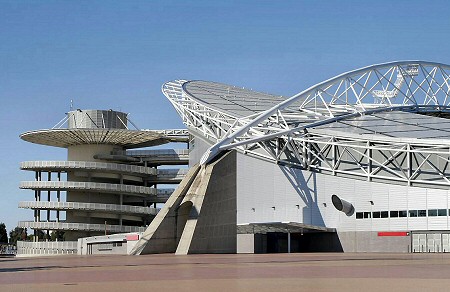
Building of the stadium, then known as Stadium Australia, was completed in March 1999. It was built to hold 110,000 spectators and cost $690 million Au to build.
The first sporting event held at the stadium in 1999 was an NRL (National Rugby League) first round double-header, featuring Newcastle v Manly and Parramatta v St George Illawarra. The games saw a record rugby league crowd of 104,583 spectators. Several other events took place later that year including the 1999 Bledisloe Cup and the 1999 National Rugby League Grand Final.
In 2000, the stadium was the centrepiece of the Sydney 2000 Olympic Games. Most of the track and field events took place here, as well as the opening ceremony, the soccer final and the closing ceremony. The highest ever attendance was 114,714 people during the closing ceremony.
In late 2001, extensive work began to make the stadium more suitable for other events. Changes were made to allow the stadium to host events like cricket and Australian Rules football that required an oval field. The athletics track was removed.
The north and south wings were shortened and movable seating was installed. This reduced seating capacity to 83,500. Awnings were also added over the north and south wings, making most of the seating under cover.
In 2002, the stadium was renamed Telstra Stadium. Since then, it has hosted many major sporting events including the 2003 Rugby World Cup Final and the second leg of the Oceania-South America Qualification Playoff game for the 2006 FIFA World Cup.
Telstra Stadium is now a regular venue for a number of sports including the NRL, State of Origin, Australian football, rugby union and cricket. Concerts are also held here.
The Design Of Telstra Stadium:
Telstra Stadium was designed by Bligh Lobb Sports Architects. It was built specifically with the harsh Australian climate in mind and with the aim of being environmentally responsible. It is one of the few stadiums in the world that effectively protects the spectators from the elements without fully enclosing the dome and damaging the grass.
The roof is suspended from a huge arch structure. It is made from a translucent polycarbonate so is non-reflective. Its shape also allows for the collection and reuse of rainwater.
The design is said to have been inspired by the shape of the akubra, an Australian hat.
Telstra Stadium Tours:
Telstra Stadium’s interactive tours give you the opportunity to go behind the scenes for an inside view of one of the world’s most technologically advanced stadiums. You will be able to follow in the footsteps of some of the world’s finest athletes and relive many of the great sporting achievements from the Sydney 2000 Olympic Games. The tour features a mixture of audio-visual & commentary from your guide. Highlights of the tour include walking down the player’s tunnel onto the field, visiting the changing rooms and warm-up areas, seeing the media areas and standing on the medal podium.
Souvenir photos of you on the medal podium are available for an extra fee.
Important Information:
Admission:
Guided tours cost $27.50 Au for adults or $15.00 Au for children. Admission is free with a See Sydney Card.
Location:
Telstra Stadium is located at Sydney Olympic Park, Homebush, approximately 30 minutes west of the city or 10 minutes from Parramatta. It is easily accessible by public transport and by car.
Trains operate regularly between the city and Sydney Olympic Park. The stadium is a short walk from the train station.
Buses 525 and 401/404 travel to Sydney Olympic Park from Parramatta Station, Strathfield Station, Lidcombe Station and Sydney Olympic Park Ferry Wharf.
Ferries operate from Circular Quay and Rydalmere and take you to the Sydney Olympic Park Ferry Wharf. From there, take a bus to the stadium (the bus ride is included in the price of your ferry ticket).
Parking is also available on site for a fee.
During special events, special bus services also operate from numerous locations.
Nearby Attractions:
Nearby attractions include the Sydney Olympic Park Listen Live Tour, the Observation Centre at Homebush Bay and the Sydney International Aquatic Centre.
Opening Hours:
Telstra Stadium tours operate daily at 11.00am, 12.30pm, 2.00pm and 3.30pm. Tours do no operate on Christmas Day and some event days.
Access:
Telstra Stadium is easily accessible by wheelchair.
Contact Details:
You can contact Telstra Stadium directly on (02) 8765 2000.
For more information and to find out about current events, please visit the Telstra Stadium website at www.telstrastadium.com.au
Have You Visited Telstra Stadium?
Please share your experiences of or questions about Telstra Stadium in the comments box below.
Experiment Farm Cottage
Posted on January 3, 2008 - Filed Under Historic Sites, Parramatta
Tags: Experiment Farm Cottage, Parramatta, Sydney Historic Sites, things to do in Sydney
Experiment Farm Cottage is the site of the first land release and the first farm in Australia. The cottage is one of Australia’s oldest surviving buildings. It was built in the 1830s and is now home to a unique collection of Colonial furniture. It provides a window into the lifestyle of an important family in the early colony while the cellars house a museum. The museum details all phases of occupation and celebrates the life and achievements of ex-convict and farmer, James Ruse.
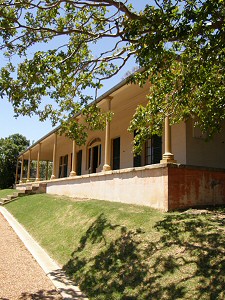
James Ruse:
The farm was originally established as an experiment in 1789. Governor Phillip believed agricultural self-sufficiency was crucial if the colony was to survive and wanted to test whether or not it could be achieved. He granted the land to ex-convict James Ruse on the condition that he attempt to establish a farm that could support and feed a family with little start-up assistance.
Ruse was given one and a half cleared acres of land and assistance in clearing another five acres. He was provided with two sows and six hens. He was also fed and clothed from the public store until he was able to provide for himself. Ruse achieved self-sufficiency quite quickly and was rewarded with further land grants, bringing his total property to 30 acres.
John Harris:
In 1793 Ruse sold his property to military surgeon John Harris for £40. Harris was originally from Ireland but was stationed at Parramatta in 1789. He soon gained favour and was granted land in the area. Through further grants and purchases, his land grew to 315 acres by the turn of the century.
Harris divided his time between being a surgeon and a farmer. In the early 1800s, he also took on the role of a magistrate. The position began in tumultuous time for Harris. He was disbarred and re-instated on multiple occasions until he officially retired in 1814. He settled down in Sydney with his wife and devoted his life to farming. However, he continued to play an active role in the community. He was a member of several public committees and was involved in the establishment of Australia’s first bank, the Bank of New South Wales. He also acted as surgeon on Oxley’s expedition to Bathurst and once again became a magistrate.
Harris built the Indian Bungalow now know as Experiment Farm Cottage sometime during the 1830s. It was not his permanent residence, but he often stayed there when his work brought him to the Parramatta area. Unfortunately though, he was unable to enjoy his bungalow for long as he passed away in 1838.
The National Trust:
Experiment Farm Cottage become one of the first properties acquired by the National Trust after one of its members noticed it going up for sale. The cottage then underwent extensive restoration to return it to its previous state. It is now furnished with simple, elegant pieces from the National Trust’s collection to reflect Harris’s lifestyle. The gardens have also been landscaped to show how it would have looked when Harris occupied the homestead.
Important Information:
Admission:
General admission is $6.00 Au for adults or $4.00 Au for children and includes a guided tour of the home.
Admission is free with a See Sydney Card.
Location:
Experiment Farm Cottage is located at 9 Ruse Street, Harris Park (near Parramatta), about 40 minutes west of Sydney’s CBD. It is easily reached by car or public transport.
If arriving by public transport, take the train to Parramatta Station or the River Cat from Circular Quay to Parramatta. From there it is approximately a 15 minute walk. For a map on how to get there, please visit www.whereis.com.au and type in the address.
Free parking is available on site.
Nearby Attractions:
Nearby attractions include Elizabeth Farm, Hambledon Cottage and Old Government House.
Opening Hours:
Experiment Farm Cottage is open 10:30am-3:30pm Tuesday to Friday and 11:00am-3:30pm on weekends and public holidays.
Food Services:
There are picnic grounds on site.
Access:
Disabled entry is via the back door. There is no disabled access to the cellar.
Contact Details:
You can contact Experiment Farm Cottage directly on (02) 9635 5655.
Have You Visited Experiment Farm Cottage?
Please share your experiences of or questions about Experiment Farm Cottage in the comments box below.
Sydney New Years Celebrations
Posted on December 18, 2007 - Filed Under Special Events
Tags: Sydney Fireworks, Sydney Harbour Bridge, Sydney New Years
Sydney New Years celebrations are widely acknowledged as the best in the world and are an experience not to be missed. The highlight of the celebrations is the dazzling fireworks display held in and around Sydney Harbour, of which the Sydney Harbour Bridge is the centrepiece.
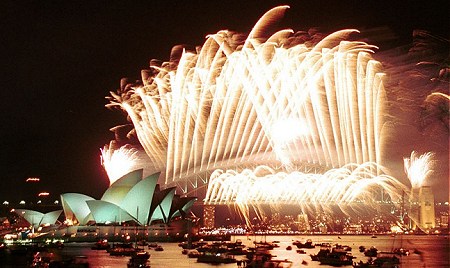
Over 1 million people gather around the harbour every year to join in the festivities – that’s more people celebrating around Sydney Harbour than in New York’s Times Square!
The Theme:
Each year the party is centred around a theme. This year’s theme (2007/2008) is The Time Of Our Lives and will be symbolised by images of clocks and hourglasses. The images will appear throughout the city on signs and banners and will also feature in the fireworks and Sydney Harbour Bridge display.
The Timetable:
Sydney New Years celebrations officially kick off at 1pm with the firing of the Fort Denison Cannon. Events are then scheduled at hourly intervals throughout the afternoon and evening, finally culminating with incredible fireworks displays.
The timetable is:
1pm – The Fort Denison Cannon is fired
2pm – Sky Writing
3pm – Formation Flyovers starring Tiger Moths and Boeing Stearmans
4pm – Formation Flyovers starring Boeing Stearmans and Beechcraft Staggerwing
5pm – Pitt Specials Flyover
6pm – Tiger Moths, Boeing Stearmans, Beechcraft Staggerwing and a Pitt Special
Flyover
7pm – Fire Tug Display
8pm – Indigenous Welcome Ceremony on Sydney Harbour, a ritual of purification
and unity.
9pm – Family Fireworks and Harbour of Light Parade
10pm – Unveiling of Sydney Harbour Bridge Effect
11pm – Unveiling of Sydney Harbour Bridge Effect
12am – Fireworks and Sydney Harbour Bridge Effect
Family Fireworks:
Every year, Sydney puts on a magical fireworks display at 9pm so that children can also celebrate the New Year. This year’s display will run for 8 minutes and feature four firing barges and special effects never seen before on the harbour.
The Harbour of Light Parade:
The Harbour of Light Parade will immediately follow the Family Fireworks. This parade will feature over 50 boats including Sydney’s Heritage Fleet, Sydney Ferries, Tall Ships and private vessels. Each will feature an illuminated emblem to represent this year’s theme. They will follow a 15km circuit around Sydney Harbour, including passage through the exclusion zone.
You can be a part of the parade and get the best vantage point for the fireworks without all the crowds by booking your ticket aboard one of these vessels.
Click here to view the options.
Midnight Fireworks:
The midnight fireworks spectacular will be the largest and most complex fireworks display on record. It will feature millions of dollars worth of pyrotechnics and 30,000 effects. Fireworks will be launched from six barges on the harbour and from the tops of eight city buildings. Keep an eye open for the brand new 3D fireworks that form dazzling cubes, shells and other shapes in the sky.
This year will also feature the most elaborate and dynamic bridge effect yet. And of course, they aren’t telling us what it is yet! We’ll just have to wait until New Year’s Eve to find out.
Vantage Points:
There are free vantage points all around Sydney Harbour. Keep in mind that crowds start to gather very early in the day with most of the best vantage points taken by lunch time. Some areas will be closed off once the crowds reach a certain level for safety reasons.
For the ultimate Sydney New Years experience, book a ticket on board one of the luxury cruisers participating in the Harbour of Lights Parade. Not only will you be able to experience the parade first hand but you will have the best vantage point for both the 9pm family fireworks display and the midnight fireworks spectacular. You will be celebrating in comfort and without the crowds.
Make sure you book soon, as tickets are selling out fast.
Click here for more information and to book your spot in the Harbour of Lights Parade.
Please Think Ahead:
If you are taking children to the event, keep them close to you at all times and make sure they know what to do if they get lost. Huge crowds gather in Sydney for the celebrations so please make sure you are well prepared. I also recommend taking lots of water as you may find it difficult to weave your way in and out of the crowds just to buy a drink.
Are You Joining Sydney’s New Years Celebrations?
Please share your experiences of or questions about Sydney New Years Celebrations in the comments box below.
Taronga Zoo
Posted on December 14, 2007 - Filed Under Wildlife Experiences
Tags: Sydney Zoo, Taronga Park Zoo, Taronga Zoo, things to do in Sydney
Taronga Zoo is known as the ‘zoo with a view’ due to its location on a hill overlooking Sydney Harbour. It covers 28 hectares and offers stunning views of the harbour, the Sydney Harbour Bridge and the Sydney Opera House. It is home to over 2600 Australian and international animals representing approximately 340 species.
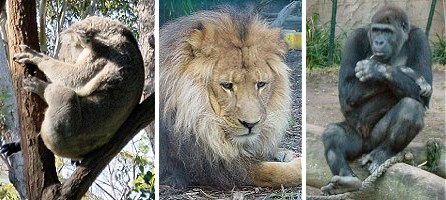
History of Taronga Zoo:
Taronga Zoo was the first public zoo in New South Wales. It opened in 1884 in Moore Park on the site now occupied by Sydney Boys High School. In 1908, the secretary of the zoo was inspired by a visit to Hamburg Zoo in Germany, returning to Sydney with the dream of building a bar-free zoo. He soon realised this would not be possible at the original site. In 1916 the zoo was moved to Mosman to give the animals more space and allow for future growth.
The first animals to call the new zoo home included monkeys, seals, elephants and more than 500 birds. A giraffe house, tiger pits and an aquarium were added soon after followed by larger cats, apes, gorillas and koalas.
In 1967 the zoo shifted to a new focus on scientific research, conservation and education. Platypus and nocturnal houses, waterfowl ponds and a rainforest aviary were established. A Veterinary Quarantine Centre and an Education Centre were also added while other attractions like the miniature train and the elephant rides were removed.
The zoo continues to advance by creating more open and natural environments for the animals, participating in education projects and devoting extensive resources to further scientific research.
The Animals:
Taronga Zoo is home to a wide variety of Australian animals. You can find them in several different areas of the zoo. These include:
- The Koala Walkabout – a close up look at the koala, Australia’s favourite animal. For a fee, you can have your photo taken with a koala, but touching them is strictly forbidden.
- The Platypus House – see one of Australia’s most unique animals, the platypus. The Common Wombat and the Spinifex Hopping-mouse also reside here.
- The Australian Walkabout – allows you to walk in amongst the kangaroos, wallabies and emus.
- The Australian Wetlands – home to a number of species including brolgas, Australian pelicans, several species of ducks and black-necked storks.
- Australian Rainforest Aviary – see some of Australia’s most beautiful birds including parrots, lorikeets, rosellas and doves.
- Australian Bush Birds – more Australian birds including kookaburras, kingfishers, lorikeets, honeyeaters, wrens, finches and cockatoos.
- Wild Australia – a great place for spotting echnidas, dingos and Tasmanian devils.
- Australian Nightlife – home to a variety of nocturnal animals including bilbies, possums, gliders and bandicoots.
- Reptile World – home to a variety of Australian lizards and snakes.
The zoo is also home to many species from around the world. They include bears, monkeys, gorillas, gibbons, zebra, giraffes, seals and sea lions, big cats like lions and tigers, bongo, meerkats, red pandas, giant tortoises and elephants.
The zoo runs several feeding sessions and educational presentations throughout the day. Make sure you check times on arrival.
Getting Around The Zoo:
Taronga Zoo is located on a hill so can be tiring to walk around. Where possible, start at the top of the zoo and walk down. The Sky Safari cable car runs through the treetops offering not only an easy way to reach the top but also spectacular views of Sydney and the animals below.
Up Close And Personal At The Zoo:
There are several tours available that give you a much more personalised and close up look at the zoo and the animals that live there. These tours give you the opportunity to feed some animals, go to areas where the general public are not allowed and learn more about the animals you are seeing. Recommended tour options include the Sydney Taronga Zoo’s Australian Animals Tour or the Sydney Taronga Zoo’s Wild Australia Experience.
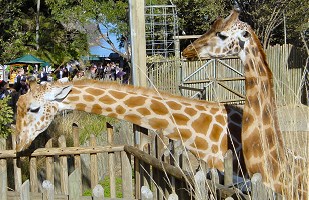
Important Information:
Admission:
General admission is $37.00 Au for adults or $18.00 Au for children. A Family Pass for 2 adults and 2 children is $93.00 Au.
Click Here to view General Admission and Tour Options.
Admission is free with a See Sydney Card.
Zoo Passes including admission to the zoo, use of the Sky Safari cable car, use of the bus from Taronga Wharf to the top of the zoo and return transport aboard Sydney ferries are available from ferry ticket offices at Circular Quay. They cost $44.00 Au for the first adult, $38.00 for the second adult, $21.50 Au for the first child and $13.50 Au each for additional children.
Location:
Taronga Zoo is located on Bradley’s Head Rd in Mosman. It can be reached by car or public transport.
The most popular way to get there is by ferry from Circular Quay. Services operate every 30 minutes. The ride takes around 12 minutes and brings you right to the bottom of the zoo. From the Taronga Wharf, take the bus or the Sky Safari cable car to the top of the zoo.
Alternatively, Matilda Cruises operates an express service aboard their cruise rockets to the zoo from Darling Harbour and Circular Quay.
You can also take bus 247 between Wynyard bus station and the zoo’s main entrance. The ride takes approximately 30minutes.
Parking is available for a $10.00 Au fee. It is payable on your way out.
Nearby Attractions:
While at the zoo you can enjoy picturesque views of Sydney Harbour, the Sydney Harbour Bridge and the Sydney Opera House.
Opening Hours:
Taronga Zoo is open 9:00am-5:00pm, 7 days a week, including Christmas Day.
Food Services:
There are several food choices available at the zoo ranging from fast food outlets to a sit down restaurant and cafe. There are also a number of picnic areas if you wish to bring your own food.
Shop:
There are several gift shops located throughout the zoo. Most merchandise is related to wildlife and the environment and focuses heavily on education. The zoo is renowned for its soft toys due to focus they place on providing the best possible representation of the animals. Profits made from all merchandise sales are invested back into the zoo’s programs for the care and conservation of wildlife.
Access:
Wheelchairs are available for hire free of charge. Calling ahead to book is recommended. Strollers can also be hired for $12.00 Au a day.
Contact Details:
You can contact Taronga Zoo directly on (02) 9969 2777.
Have You Visited Taronga Zoo?
Please share your experiences of or questions about Taronga Zoo in the comments box below.
« go back — keep looking »


